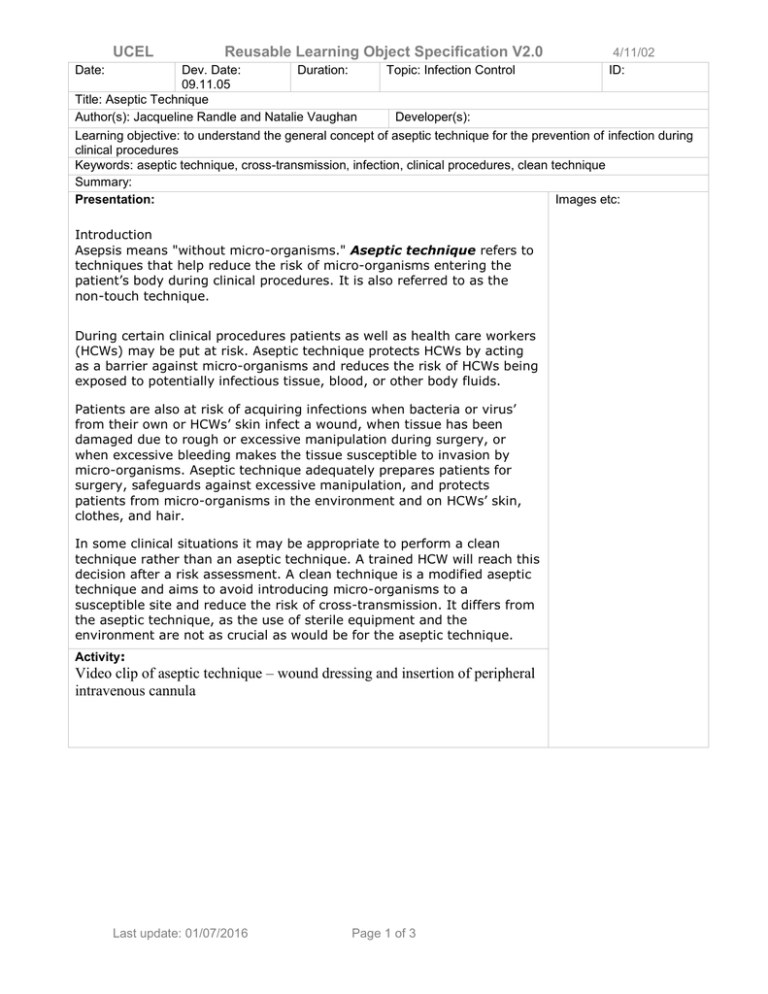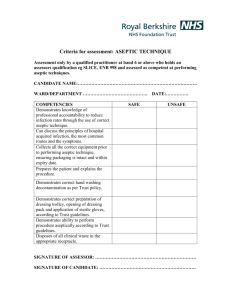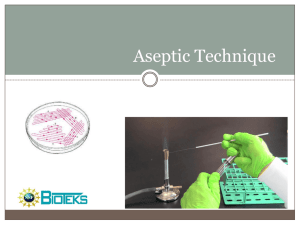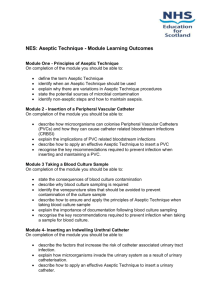UCEL Reusable Learning Object Specification V2.0
advertisement

UCEL Reusable Learning Object Specification V2.0 4/11/02 Dev. Date: Duration: Topic: Infection Control ID: 09.11.05 Title: Aseptic Technique Author(s): Jacqueline Randle and Natalie Vaughan Developer(s): Learning objective: to understand the general concept of aseptic technique for the prevention of infection during clinical procedures Keywords: aseptic technique, cross-transmission, infection, clinical procedures, clean technique Summary: Presentation: Images etc: Date: Introduction Asepsis means "without micro-organisms." Aseptic technique refers to techniques that help reduce the risk of micro-organisms entering the patient’s body during clinical procedures. It is also referred to as the non-touch technique. During certain clinical procedures patients as well as health care workers (HCWs) may be put at risk. Aseptic technique protects HCWs by acting as a barrier against micro-organisms and reduces the risk of HCWs being exposed to potentially infectious tissue, blood, or other body fluids. Patients are also at risk of acquiring infections when bacteria or virus’ from their own or HCWs’ skin infect a wound, when tissue has been damaged due to rough or excessive manipulation during surgery, or when excessive bleeding makes the tissue susceptible to invasion by micro-organisms. Aseptic technique adequately prepares patients for surgery, safeguards against excessive manipulation, and protects patients from micro-organisms in the environment and on HCWs’ skin, clothes, and hair. In some clinical situations it may be appropriate to perform a clean technique rather than an aseptic technique. A trained HCW will reach this decision after a risk assessment. A clean technique is a modified aseptic technique and aims to avoid introducing micro-organisms to a susceptible site and reduce the risk of cross-transmission. It differs from the aseptic technique, as the use of sterile equipment and the environment are not as crucial as would be for the aseptic technique. Activity: Video clip of aseptic technique – wound dressing and insertion of peripheral intravenous cannula Last update: 01/07/2016 Page 1 of 3 UCEL Reusable Learning Object Specification V2.0 Assessment: True or false statements Statement 1. Aseptic technique may be defined as a method to prevent microbial contamination of wounds and other susceptible sites 2. Using an aseptic technique may help to prevent a healthcare associated infection 3. Only clean objects and fluids must come into contact with wounds and other susceptible sites 4. Performing an aseptic technique at the bedside whilst beds are being made does not increase the risk of airborne contamination 5. An aseptic technique is not necessary when introducing an invasive device, for example a urinary catheter / peripheral cannula 6. The most effective solution to be used to clean a dressings trolley is an alcohol spray 7. An aseptic technique is often achieved by using either forceps or non-sterile gloves 8. Using gloves whilst performing an aseptic technique will provide a greater sensitivity and a decreased risk of trauma to the patient 9. InLast theupdate: context of 01/07/2016 aseptic technique, effective hand decontamination is the Page 2 of 3 4/11/02 UCEL Reusable Learning Object Specification V2.0 Links (1): www.icna.co.uk Asepsis: Preventing Healthcare Associated Infection 4/11/02 Links (2): Glossary: Related concepts: Author’s notes: Time: Last update: 01/07/2016 Dev’s notes: Total: Total: Page 3 of 3



